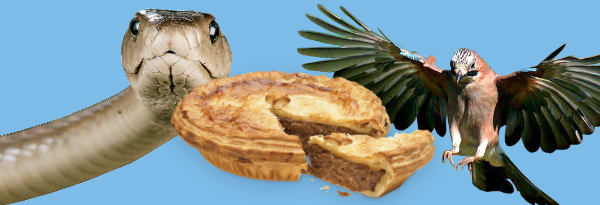Full of love: The world of wedding food
There's more to weddings than cake, apparently.
Ancient Rome: Let's break a cake
In ancient Rome, wedding ceremonies ended by breaking a cake made from wheat or barley over the bride’s head to symbolise good fortune. The newlyweds then ate some of the crumbs in a custom known as confarreatio, or ‘eating together’. The wedding guests would then gather up the breadcrumbs as little tokens of good luck.
Unfortunately, it doesn’t seem like this is where the word ‘confetti’ comes from. Instead, we get the word from a type of Italian sweet of the same name, which was traditionally thrown at carnivals.
China: Surf and turf for harmony
In ancient China, when a couple became betrothed, it was custom for the groom-to-be’s family to give bridal cakes to the bride-to-be’s family. These would be handed out to friends and relatives as a kind of invitation to the wedding feast.
In parts of China, it’s also traditional for chicken and lobster to be served alongside each other at weddings. Chicken symbolises the phoenix, while lobster symbolises the dragon. In feng shui, the phoenix and dragon are the perfect couple and thus come together to create a harmonious feast for wedding banquets.
Vietnam: Sticky rice and steamy nights
According to the Lĩnh Nam chích quái, a 14th century Vietnamese work of fiction, when a couple got engaged they would give each other a gift of salt and when it came to time to celebrate the wedding, they’d kill and feast on cattle.
Meanwhile, on the wedding night, to mark their intention to consummate the marriage, sticky (ahem) rice was shared between the bride and groom. This practice is still followed today and bridal rice - Xôi Gấc - is dyed red with gac fruit for good luck.
Britain: Pies within pies with an added surprise
In Britain, before big white weddings with their multi-tiered cakes, there was a much simpler dish which took pride of place during the matrimonial meal. A pie. In fact, a pie is the earliest British recipe designed specifically for a wedding. It was called ‘an extraordinary Pie’ or a ‘Bride Pye’ and was ‘only for a wedding to pass away time’.
The earliest source (from 1665) was all about building pies within pies. But it didn’t end there. The author also advised putting ‘live birds or a snake’ into the pie which, he notes, ‘seem strange to the beholders’. It’s unknown whether people did add live animals or not, but from records we can see the custom of serving elaborate wedding pies existed in parts of Britain up until the 1870s.
Seriously though, why eat cake when you can eat pie?
Britain: Royalty and the fruit cake
As far back as medieval times, special occasions in England have been celebrated with fruit cakes. They were perfect in a time before fridges as their high alcohol content meant they wouldn’t go off.
One early version of the tradition involved small spiced buns stacked one on top of the other, as tall as possible. If the bride and groom could kiss over the sweet tower of buns it signified a lifetime of happiness.
The wedding of Queen Victoria in 1840 started a tradition of royal fruit cakes. Hers was an immense 300 pound plum cake which caused a public frenzy and, as one author puts it, ‘was to be seen, but not necessarily eaten’. Every royal wedding since Victoria’s has been celebrated with a fruit cake, apart from Harry and Meghan’s. They broke with tradition and opted for an organic Amalfi lemon and English elderflower cake instead.
Fun 'fact': According to a rumour floating around the internet, mint chop chip ice cream was invented for Princess Anne's wedding in 1973.
Scandinavia: Put a ring on it
The Norwegians and Danish have a speciality cake called kransekake, which translates to ‘wreath’ or ‘tower’ cake. Made from ground almonds, sugar and egg white this cake, commonly baked for weddings, is made up of biscuity marzipan rings which are stacked one on top of the other, from small to large, in a cone tower which reaches 18 rings or higher. As one author highlights, ‘A bottle of wine fits nicely inside’.
In the Norwegian tradition, the bride and groom lift off the top layer and the number of rings that come off with it signify how many children the couple will have.
The UK & USA: Cake for men
Originating in Victorian England, the groom’s cake was considered ‘dark… practical, substantial’, while the bride’s cake was seen as ‘frilly, decorative, not meant to be eaten’.
It’s fallen out of fashion in the UK, though a version did crop up at Prince William and Kate Middleton’s wedding in 2011. William opted for a McVitie’s Chocolate Biscuit Cake, made from crushed biscuits, golden syrup, butter, cocoa and sugar.
Groom’s cake remains a popular tradition in the Southern United States. In some parts of the South the cake isn’t made for eating. Instead slices are given out to unmarried female guests so they can put them under their pillows and dream of their future spouse.













